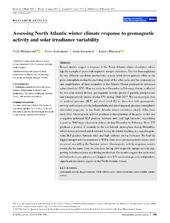| dc.contributor.author | Maliniemi, Ville Aleksi | |
| dc.contributor.author | Asikainen, Timo | |
| dc.contributor.author | Salminen, Antti | |
| dc.contributor.author | Mursula, Kalevi | |
| dc.date.accessioned | 2020-06-26T11:32:19Z | |
| dc.date.available | 2020-06-26T11:32:19Z | |
| dc.date.issued | 2019 | |
| dc.Published | Maliniemi VA, Asikainen T, Salminen A, Mursula K. Assessing North Atlantic winter climate response to geomagnetic activity and solar irradiance variability. Quarterly Journal of the Royal Meteorological Society. 2019;145(725):3780-3789 | eng |
| dc.identifier.issn | 1477-870X | en_US |
| dc.identifier.issn | 0035-9009 | en_US |
| dc.identifier.uri | https://hdl.handle.net/1956/23043 | |
| dc.description.abstract | Recent studies suggest a response in the North Atlantic winter circulation which lags by a couple of years with respect to sunspot maximum. This has been explained by two different top‐down mechanisms: a solar wind driven particle effect in the polar atmosphere during the declining phase of the solar cycle, and the re‐emergence and amplification of heat anomalies in the Atlantic Ocean produced by enhanced solar ultraviolet (UV). Here we study how December to February climate is affected by two solar‐related drivers: geomagnetic activity (proxy of particle precipitation) and sunspot activity (proxy of solar UV) during 1948–2017. We use reanalysis data of sea‐level pressure (SLP) and zonal wind (U) to show that both geomagnetic activity and sunspot activity independently and simultaneously produce atmospheric circulation responses in the North Atlantic whose evolutions clearly differ from each other. Geomagnetic activity produces a strengthening of the polar vortex and a negative poleward SLP gradient between mid‐ and high latitudes, resembling a positive NAO‐type circulation pattern during December to February. Solar UV produces a positive U anomaly in the low‐latitude stratosphere during December, which moves poleward and downward during the winter resulting in a negative poleward SLP gradient between mid‐ and high latitudes during February. We find the lagged sunspot activity responses in SLP to form zonal pressure patterns (wave‐train structure) resembling the Eurasian pattern. Geomagnetic activity responses remain essentially the same when we introduce the lag with respect to sunspot activity supporting its independency as a driving mechanism. Our results suggest that solar wind related particle precipitation and (lagged) solar UV mechanism provide independent, significant circulation signals in the North Atlantic winter. | en_US |
| dc.language.iso | eng | eng |
| dc.publisher | Wiley | en_US |
| dc.rights | Attribution-NonCommercial CC BY-NC | eng |
| dc.rights.uri | http://creativecommons.org/licenses/by-nc/4.0/ | eng |
| dc.title | Assessing North Atlantic winter climate response to geomagnetic activity and solar irradiance variability | en_US |
| dc.type | Peer reviewed | |
| dc.type | Journal article | |
| dc.date.updated | 2020-02-05T10:01:24Z | |
| dc.description.version | publishedVersion | en_US |
| dc.rights.holder | Copyright 2019 The Author(s) | en_US |
| dc.identifier.doi | https://doi.org/10.1002/qj.3657 | |
| dc.identifier.cristin | 1781121 | |
| dc.source.journal | Quarterly Journal of the Royal Meteorological Society | |

